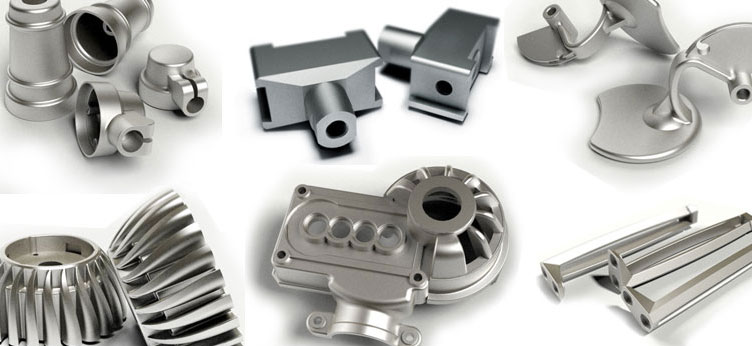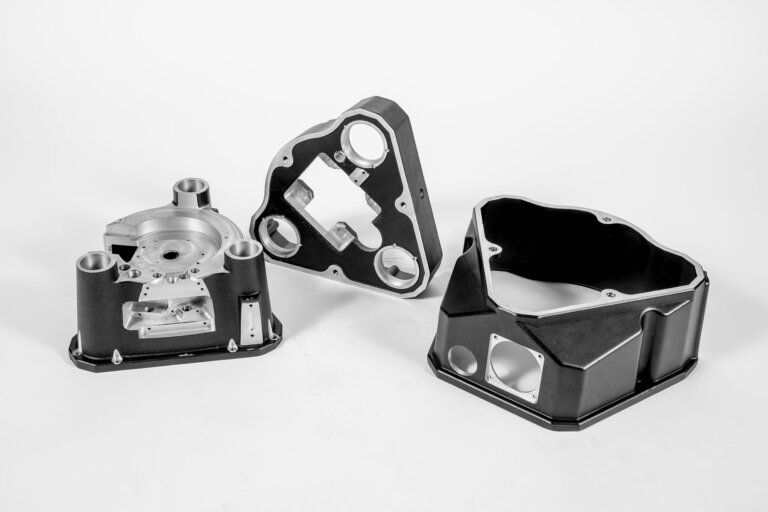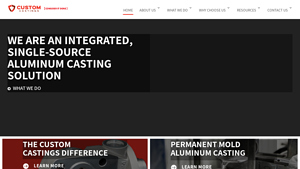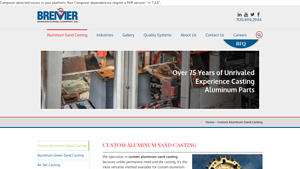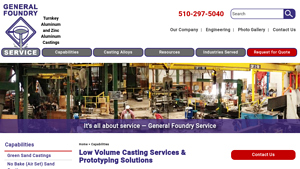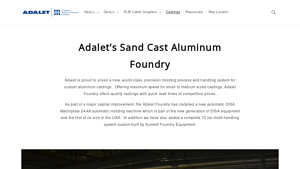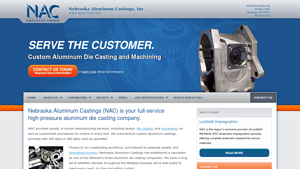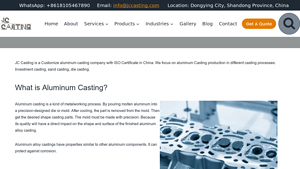Custom Aluminum Casting Guide: Type, Cost, Top List…
Introduction: Navigating the Global Market for custom aluminum casting
In the rapidly evolving landscape of global manufacturing, sourcing high-quality custom aluminum casting solutions presents a significant challenge for international B2B buyers. With diverse applications ranging from automotive components to intricate aerospace parts, understanding the nuances of various casting methods—such as sand casting, permanent mold casting, and investment casting—is crucial for making informed decisions. This comprehensive guide delves into the intricacies of custom aluminum casting, addressing key factors such as supplier vetting, material selection, production costs, and delivery timelines.
By equipping buyers from Africa, South America, the Middle East, and Europe with actionable insights, this guide empowers them to navigate the complexities of sourcing aluminum castings effectively. It highlights best practices for evaluating suppliers, ensuring quality control, and optimizing designs for manufacturability, ultimately leading to reduced costs and improved lead times. Whether you are seeking to enhance your product offerings or streamline your supply chain, this resource serves as an invaluable tool for making strategic purchasing decisions in the competitive global market. With a clear understanding of the available options and expert guidance, you can confidently partner with the right manufacturers to meet your unique requirements.
Understanding custom aluminum casting Types and Variations
| Type Name | Key Distinguishing Features | Primary B2B Applications | Brief Pros & Cons for Buyers |
|---|---|---|---|
| Permanent Mold Casting | High precision, reusable molds, suitable for high-volume production | Automotive, Aerospace, Consumer Goods | Pros: Cost-effective for large runs, excellent surface finish. Cons: Higher initial tooling costs. |
| Sand Casting | Versatile, low-cost, suitable for complex shapes | Industrial Equipment, Marine, Artifacts | Pros: Low setup costs, adaptable to various designs. Cons: Limited precision compared to other methods. |
| Air Set (No-Bake) Casting | Uses chemically bonded sand, allows for complex geometries | Heavy Machinery, Construction Components | Pros: Good dimensional stability, suitable for larger parts. Cons: Slower production rates compared to permanent molds. |
| Investment Casting | High precision, thin walls, intricate details | Medical Devices, Aerospace Components | Pros: Excellent surface finish, tight tolerances. Cons: Higher cost per unit, longer lead times. |
| 3D Printed Sand Mold Casting | Rapid prototyping, flexible design options | Prototyping, Low-Volume Production | Pros: Quick turnaround, cost-effective for small batches. Cons: Limited material options and lower strength. |
What Are the Characteristics of Permanent Mold Casting?
Permanent mold casting is characterized by its use of reusable molds, typically made from metal, which allows for high precision and consistent quality in production. This method is particularly suitable for high-volume manufacturing, making it ideal for industries such as automotive and aerospace, where components require stringent tolerances and durability. Buyers should consider the higher initial tooling costs against the long-term savings from reduced per-unit costs, especially for large production runs.
How Does Sand Casting Differ from Other Methods?
Sand casting is renowned for its versatility and cost-effectiveness, making it one of the oldest casting methods still in use today. It is particularly useful for producing complex shapes and larger components, such as those found in industrial equipment and marine applications. While it offers low setup costs and adaptability, buyers should note that sand casting typically provides lower precision compared to methods like permanent mold or investment casting, which may affect the final product’s performance in specific applications.
What Advantages Does Air Set (No-Bake) Casting Offer?
Air set casting employs chemically bonded sand to create molds, allowing for intricate designs and larger parts. This method is often utilized in heavy machinery and construction components due to its good dimensional stability. While it can accommodate complex geometries, buyers should be aware that production rates may be slower compared to permanent mold casting. The decision to use air set casting should factor in the specific requirements of the project, including part size and detail complexity.
Why Choose Investment Casting for Precision Parts?
Investment casting, also known as lost wax casting, is ideal for producing parts with high precision and intricate details, making it a popular choice in industries like medical devices and aerospace. This method allows for thin walls and excellent surface finishes, but buyers should consider the higher cost per unit and longer lead times associated with this casting type. It is essential for B2B buyers to evaluate the balance between the need for precision and the associated costs when selecting this method.
How Does 3D Printed Sand Mold Casting Facilitate Prototyping?
3D printed sand mold casting is a modern approach that leverages additive manufacturing to create molds quickly and efficiently. This method is particularly beneficial for prototyping and low-volume production, as it allows for rapid iteration and flexibility in design. While it offers quick turnaround times and cost-effectiveness for small batches, buyers should be mindful of the limited material options and potential strength limitations compared to more traditional casting methods. This makes it best suited for initial testing and development phases rather than final production.
Key Industrial Applications of custom aluminum casting
| Industry/Sector | Specific Application of custom aluminum casting | Value/Benefit for the Business | Key Sourcing Considerations for this Application |
|---|---|---|---|
| Automotive | Engine components, transmission housings | Lightweight, high-strength parts leading to improved fuel efficiency and performance. | Compatibility with existing designs, precision tolerances, and alloy specifications. |
| Aerospace | Structural components for aircraft | Enhanced durability and weight reduction, contributing to fuel savings and increased payload capacity. | Certification requirements, stringent quality control, and adherence to aerospace standards. |
| Electronics and Telecom | Enclosures and heat sinks | Effective thermal management and protection of sensitive electronic components. | Customization capabilities, surface finish options, and compliance with electromagnetic interference (EMI) standards. |
| Medical Equipment | Surgical instruments, casings for devices | High precision and reliability, ensuring safety and functionality in critical applications. | Biocompatibility, sterilization processes, and regulatory compliance for medical devices. |
| Construction and Infrastructure | Structural elements, fittings, and fixtures | Cost-effective solutions for durable, lightweight, and corrosion-resistant components. | Material specifications, load-bearing capacities, and environmental resistance standards. |
How Is Custom Aluminum Casting Used in the Automotive Industry?
In the automotive sector, custom aluminum casting is pivotal for manufacturing lightweight engine components and transmission housings. These components are designed to enhance vehicle performance by reducing weight, which directly translates to improved fuel efficiency. Buyers in this industry must ensure that cast parts meet specific compatibility and precision tolerances, as well as alloy specifications to withstand the demanding automotive environment.
What Are the Applications of Custom Aluminum Casting in Aerospace?
Aerospace applications leverage custom aluminum casting for structural components due to the material’s high strength-to-weight ratio. Parts such as fuselage frames and engine mounts benefit from this technology, allowing for significant weight reductions that contribute to fuel savings and increased payload capacity. International buyers must consider stringent certification requirements and quality control measures to comply with aerospace standards, ensuring safety and reliability.
How Does Custom Aluminum Casting Benefit Electronics and Telecom?
In the electronics and telecom industries, custom aluminum casting is employed for producing enclosures and heat sinks that protect sensitive components. The lightweight yet durable nature of aluminum aids in effective thermal management, which is crucial for device performance and longevity. Buyers should focus on customization capabilities and surface finish options to meet specific electromagnetic interference (EMI) standards, ensuring optimal device functionality.
Why Is Custom Aluminum Casting Important for Medical Equipment?
Custom aluminum casting plays a critical role in the medical equipment sector by providing high-precision components, such as surgical instruments and casings for medical devices. These castings must ensure reliability and safety in critical applications, making their performance non-negotiable. Buyers need to prioritize biocompatibility, sterilization processes, and adherence to regulatory compliance to meet the stringent requirements of the medical industry.
What Role Does Custom Aluminum Casting Play in Construction and Infrastructure?
In construction and infrastructure, custom aluminum casting is utilized for creating structural elements, fittings, and fixtures that are both durable and lightweight. This approach provides cost-effective solutions while ensuring that components are resistant to corrosion and able to bear significant loads. Buyers in this sector should consider material specifications, load-bearing capacities, and environmental resistance standards to ensure the longevity and functionality of their projects.
3 Common User Pain Points for ‘custom aluminum casting’ & Their Solutions
Scenario 1: Navigating Complex Specifications for Custom Parts
The Problem: Many B2B buyers encounter difficulties when trying to translate their complex design specifications into actual aluminum castings. This often leads to misunderstandings with manufacturers regarding dimensions, tolerances, and material properties. Buyers may have a clear vision of their product, but without a solid grasp of the casting processes, they risk ending up with parts that do not meet their functional requirements or, worse, lead to costly reworks and delays. This is particularly problematic for buyers in industries with strict regulatory standards, such as aerospace or medical devices, where precision is critical.
The Solution: To mitigate these issues, buyers should engage in thorough pre-production consultations with potential casting suppliers. It is crucial to provide detailed drawings and specifications that include tolerances, material grades, and intended use cases. Furthermore, utilizing 3D modeling and prototyping technologies can help visualize the final product and allow for iterative feedback before actual production begins. Establishing a collaborative relationship with the manufacturer—where both parties discuss manufacturability and potential design adjustments—can lead to optimized casting designs that not only meet specifications but also reduce waste and costs. Additionally, ensuring that the supplier is experienced in the relevant casting methods and has a robust quality assurance process will provide further peace of mind.
Scenario 2: Managing Lead Times and Supply Chain Disruptions
The Problem: In today’s global market, many B2B buyers face challenges related to supply chain disruptions and unpredictable lead times, especially when sourcing custom aluminum castings from international suppliers. Delays can arise from various factors, including material shortages, transportation issues, or unexpected factory shutdowns. Such disruptions can jeopardize project timelines and ultimately impact the buyer’s ability to deliver their products to their own customers on time.
The Solution: To address lead time concerns, buyers should adopt a proactive approach by establishing strong relationships with multiple suppliers across different regions. This not only provides a fallback option in case of disruptions but also fosters competitive pricing and innovation. When requesting quotes, buyers should inquire about the supplier’s production capabilities, inventory management practices, and contingency plans. Furthermore, implementing Just-In-Time (JIT) inventory strategies can help minimize stockpiling costs while ensuring timely delivery. Buyers can also consider local suppliers to reduce shipping times and tariffs, which is particularly relevant for international markets in Africa, South America, the Middle East, and Europe. Regularly communicating with suppliers about forecasted needs and any potential changes can lead to more reliable delivery schedules.
Scenario 3: Ensuring Quality and Compliance in Custom Castings
The Problem: B2B buyers often struggle to ensure that their custom aluminum castings meet industry standards for quality and compliance. This is particularly crucial in sectors like automotive, aerospace, and medical devices, where even minor defects can lead to significant safety issues or regulatory penalties. Buyers may find it challenging to assess the quality control measures of potential suppliers, leading to uncertainty about the integrity of the final product.
The Solution: To overcome these challenges, buyers should prioritize working with suppliers who are ISO-certified and have a proven track record of compliance with relevant industry standards. Before finalizing partnerships, buyers should request information about the supplier’s quality assurance processes, including testing methods, certifications, and previous client testimonials. It is also beneficial to conduct on-site visits to the manufacturing facility to evaluate their quality control systems firsthand. Implementing a robust inspection plan, including pre-production prototypes and in-process checks, can further ensure that the castings meet the required specifications and standards. Additionally, establishing a clear communication channel for reporting defects and addressing quality concerns will create a more transparent and accountable relationship with the supplier, ultimately leading to higher-quality outcomes.
Strategic Material Selection Guide for custom aluminum casting
When selecting materials for custom aluminum casting, it is essential to understand how different alloys can affect the performance, durability, and cost of the final product. This guide analyzes four common aluminum alloys used in casting, highlighting their key properties, advantages, disadvantages, and considerations for international B2B buyers.
What are the Key Properties of Aluminum Alloy 356?
Aluminum Alloy 356 is a versatile alloy known for its excellent corrosion resistance and good mechanical properties. It has a temperature rating of up to 150°C (300°F) and is suitable for applications that require high strength and good ductility. Its fine grain structure allows for intricate designs, making it ideal for complex castings.
Pros: The alloy’s high strength-to-weight ratio makes it suitable for aerospace and automotive applications. Additionally, it can be easily machined and welded, enhancing its manufacturability.
Cons: The initial cost of Alloy 356 can be higher than other alloys, and its performance may degrade under prolonged exposure to elevated temperatures.
Impact on Application: Alloy 356 is particularly compatible with environments where corrosion resistance is critical, such as marine applications.
Considerations for International Buyers: Compliance with ASTM standards is essential for buyers in North America, while DIN standards are often preferred in Europe. Buyers from Africa and South America should ensure that suppliers can meet local quality standards.
How Does Aluminum Alloy 319 Perform in Casting Applications?
Aluminum Alloy 319 is known for its excellent casting properties and is often used in applications requiring good wear resistance and high strength. It can withstand temperatures up to 200°C (392°F) and is suitable for high-stress applications.
Pros: This alloy offers good fluidity during casting, making it ideal for intricate designs. Its wear resistance is beneficial for automotive components.
Cons: Alloy 319 can be more expensive than other aluminum alloys, and its corrosion resistance is not as robust as Alloy 356.
Impact on Application: It is particularly effective in automotive and aerospace applications where high strength and wear resistance are required.
Considerations for International Buyers: Buyers should verify that the alloy meets the relevant ASTM or JIS standards, especially in regions like the Middle East where specific certifications may be required.
What Advantages Does Aluminum Alloy 6061 Offer for Custom Castings?
Aluminum Alloy 6061 is widely used in custom aluminum casting due to its excellent mechanical properties and corrosion resistance. It can handle temperatures up to 150°C (300°F) and is known for its weldability.
Pros: The alloy is relatively cost-effective and offers good machinability, making it suitable for a wide range of applications, including structural components.
Cons: While it has good corrosion resistance, its performance may not match that of specialized alloys like 356 in severe environments.
Impact on Application: Alloy 6061 is ideal for applications in construction, automotive, and marine industries where moderate strength and corrosion resistance are required.
Considerations for International Buyers: Compliance with ISO standards is crucial for European buyers, while buyers in South America may require adherence to local regulations.
What are the Unique Properties of Aluminum Alloy 7075?
Aluminum Alloy 7075 is known for its high strength and is often used in aerospace applications. It has a temperature rating of up to 120°C (248°F) and is recognized for its excellent fatigue resistance.
Pros: This alloy offers one of the highest strength-to-weight ratios among aluminum alloys, making it suitable for high-performance applications.
Cons: Alloy 7075 is more expensive and can be challenging to machine compared to other alloys.
Impact on Application: It is particularly well-suited for aerospace and military applications where strength and weight are critical.
Considerations for International Buyers: Buyers should ensure that the alloy meets stringent aerospace standards, which may vary by region, particularly in Europe and the Middle East.
Summary Table of Material Selection for Custom Aluminum Casting
| Material | Typical Use Case for custom aluminum casting | Key Advantage | Key Disadvantage/Limitation | Relative Cost (Low/Med/High) |
|---|---|---|---|---|
| Aluminum 356 | Aerospace, marine applications | Excellent corrosion resistance | Higher initial cost | Medium |
| Aluminum 319 | Automotive components | Good wear resistance | Less corrosion resistance than 356 | Medium |
| Aluminum 6061 | Structural components, construction | Cost-effective, good machinability | Moderate corrosion resistance | Low |
| Aluminum 7075 | Aerospace, military applications | High strength-to-weight ratio | More expensive, challenging to machine | High |
This strategic material selection guide provides valuable insights for B2B buyers in various international markets, helping them choose the right aluminum alloy for their specific casting needs.
In-depth Look: Manufacturing Processes and Quality Assurance for custom aluminum casting
What Are the Key Stages in the Manufacturing Process of Custom Aluminum Casting?
The manufacturing process of custom aluminum casting typically involves several critical stages: material preparation, forming, assembly, and finishing. Each stage is vital to ensure the final product meets both the functional and aesthetic requirements of the client.
How Is Material Prepared for Custom Aluminum Casting?
Material preparation begins with selecting the appropriate aluminum alloy based on the desired mechanical properties and application requirements. Common alloys used include 319, 356, and A356, which are known for their strength, corrosion resistance, and suitability for casting. After selection, the aluminum is melted in electric crucibles to achieve the required temperature for casting.
Once melted, the molten aluminum is poured into molds. Depending on the casting method—whether sand casting, permanent mold casting, or investment casting—the molds may need to be prepped differently. For instance, sand casting requires the creation of a sand mold, which can be produced through manual or automated processes, while permanent mold casting uses reusable metal molds to ensure precision and consistency.
What Forming Techniques Are Commonly Used in Custom Aluminum Casting?
The forming stage is where the actual casting takes place. Various techniques are employed based on the complexity and requirements of the parts being produced:
- Sand Casting: This versatile method involves forming a mold from sand, which is ideal for intricate shapes. It can accommodate parts weighing from ounces to over 100 pounds.
- Permanent Mold Casting: This process utilizes reusable metal molds, providing superior dimensional accuracy and surface finish. It’s particularly effective for high-volume production runs.
- Investment Casting: Also known as lost-wax casting, this technique allows for complex geometries and thin-walled components, making it suitable for precision parts.
- 3D Printed Molds: Emerging technologies like 3D printing are revolutionizing mold-making, enabling rapid prototyping and reduced lead times for custom designs.
What Are the Assembly and Finishing Processes for Custom Aluminum Castings?
After casting, the parts may require assembly, especially if they consist of multiple components. Assembly operations could involve inserting threaded inserts, dowels, or other mechanical fasteners, depending on the design requirements.
Finishing processes are crucial for enhancing the appearance and functionality of the cast parts. Techniques include:
- CNC Machining: Ensures precise dimensions and surface finishes.
- Surface Coating: Protects against corrosion and enhances aesthetic appeal.
- Heat Treatment: Improves mechanical properties, such as strength and hardness.
What Quality Assurance Measures Are Essential in Custom Aluminum Casting?
Quality assurance (QA) is a fundamental aspect of the custom aluminum casting process, ensuring that the final products meet industry standards and client specifications.
Which International Standards Should B2B Buyers Consider?
For B2B buyers, familiarity with relevant international standards is critical. ISO 9001:2015 certification is widely recognized and ensures that the manufacturer adheres to a quality management system that consistently meets customer and regulatory requirements. Additionally, industry-specific certifications, such as CE marking for European markets or API standards for oil and gas applications, may be essential depending on the intended use of the castings.
What Are the Key QC Checkpoints in the Manufacturing Process?
Quality control in custom aluminum casting involves several checkpoints throughout the manufacturing process:
- Incoming Quality Control (IQC): This initial stage involves inspecting raw materials (e.g., aluminum ingots) for compliance with specified standards.
- In-Process Quality Control (IPQC): During the manufacturing stages, continuous monitoring is performed to detect any deviations from specifications, ensuring quality at every step.
- Final Quality Control (FQC): After production, a thorough inspection is conducted, including dimensional checks and surface quality assessments.
What Common Testing Methods Are Used to Ensure Quality?
Various testing methods are employed to verify the quality of custom aluminum castings:
- Chemical Analysis: Ensures the correct alloy composition.
- Mechanical Testing: Evaluates properties such as tensile strength and hardness.
- Non-Destructive Testing (NDT): Techniques like X-ray or ultrasonic testing help detect internal defects without damaging the part.
How Can B2B Buyers Verify Supplier Quality Control Practices?
B2B buyers must take proactive steps to verify the quality control practices of their suppliers. Here are some effective strategies:
- Conduct Audits: Regular audits can help assess the supplier’s adherence to quality standards and processes. This can include reviewing production logs, quality control documentation, and inspection records.
- Request Quality Reports: Suppliers should provide detailed reports on their quality control measures, including results from testing and compliance with international standards.
- Engage Third-Party Inspectors: For significant orders, hiring independent third-party inspectors to assess quality can provide additional assurance and credibility.
What Are the Quality Control Nuances for International B2B Buyers?
For international buyers, understanding the nuances of quality control is crucial. Different regions may have varying standards and practices. Buyers from Africa, South America, the Middle East, and Europe should ensure that their suppliers are compliant with both local and international regulations. This may involve:
- Familiarizing themselves with specific standards applicable to their region or industry.
- Ensuring suppliers have the necessary certifications to facilitate smooth cross-border transactions.
- Establishing clear communication regarding quality expectations and compliance requirements.
In conclusion, understanding the manufacturing processes and quality assurance measures in custom aluminum casting is essential for B2B buyers. By focusing on these aspects, buyers can ensure they receive high-quality products that meet their specific needs while fostering long-term relationships with reliable suppliers.
Practical Sourcing Guide: A Step-by-Step Checklist for ‘custom aluminum casting’
Introduction
Navigating the procurement of custom aluminum casting can be complex, especially for international B2B buyers. This checklist is designed to streamline your sourcing process, ensuring you make informed decisions that align with your operational needs and quality standards.
Step 1: Define Your Technical Specifications
Before approaching suppliers, clearly outline the technical specifications of your aluminum castings. This includes dimensions, tolerances, and mechanical properties required for your application. Being specific will help suppliers assess their ability to meet your needs and prevent costly revisions later.
- Considerations: What is the intended use of the part? Will it face high stress or environmental challenges?
Step 2: Research Potential Suppliers
Conduct thorough research to identify suppliers with a proven track record in custom aluminum casting. Look for companies that specialize in the specific casting methods you require, such as sand casting or permanent mold casting.
- Sources: Utilize industry directories, trade shows, and recommendations from peers in your sector.
Step 3: Evaluate Supplier Capabilities
Assess the technical capabilities of potential suppliers to ensure they can meet your specifications. This evaluation should include their equipment, production processes, and quality control measures.
- Key Questions: Do they have modern machinery? What types of aluminum alloys can they cast?
Step 4: Verify Supplier Certifications
Check that the suppliers hold relevant certifications, such as ISO 9001:2015, to ensure they adhere to international quality standards. This is crucial for maintaining quality assurance and regulatory compliance.
- What to Look For: Certifications related to environmental management, material sourcing, and specific industry standards.
Step 5: Request Samples and Prototypes
Before finalizing your order, request samples or prototypes to evaluate the quality and precision of the castings. This step allows you to assess the supplier’s capabilities firsthand and make adjustments if necessary.
- Considerations: Ensure the samples reflect the final product specifications.
Step 6: Review Pricing and Terms
Analyze the pricing structure and payment terms offered by each supplier. While competitive pricing is important, also consider factors like lead times, shipping costs, and payment flexibility.
- Negotiation Points: Discuss bulk pricing and any potential discounts for long-term contracts.
Step 7: Establish Clear Communication Channels
Once you select a supplier, establish clear lines of communication to facilitate smooth collaboration. Discuss project timelines, updates, and any potential issues that may arise during production.
- Best Practices: Regular check-ins and updates can prevent misunderstandings and delays.
By following this practical sourcing guide, B2B buyers can make informed decisions when procuring custom aluminum castings, ultimately leading to successful partnerships and high-quality products.
Comprehensive Cost and Pricing Analysis for custom aluminum casting Sourcing
What Are the Key Cost Components in Custom Aluminum Casting?
When sourcing custom aluminum casting, understanding the cost structure is crucial for international B2B buyers. The primary cost components include:
-
Materials: The choice of aluminum alloy significantly impacts pricing. Common alloys like 319 and 356 are widely used, but specialized alloys may come at a premium. Fluctuations in aluminum prices, influenced by global market trends, can also affect overall costs.
-
Labor: Labor costs vary by region and can significantly impact pricing. Regions with higher labor costs, such as Western Europe, may present higher casting prices compared to areas in Africa or South America where labor is generally less expensive.
-
Manufacturing Overhead: This encompasses the costs of maintaining machinery, utilities, and facility expenses. Advanced manufacturing processes, such as CNC machining or 3D printing, can increase overhead but may provide better precision and efficiency.
-
Tooling: Tooling costs are essential for custom designs and can vary based on complexity. Initial setup costs for molds can be significant, but they become more economical with higher production volumes.
-
Quality Control (QC): Implementing strict quality assurance processes is vital, especially for industries requiring high precision (e.g., automotive or aerospace). Costs associated with QC can include material testing, inspections, and certifications.
-
Logistics: Transportation costs, including shipping and handling, play a significant role in the total cost. International buyers must consider customs duties, freight costs, and the reliability of logistics partners.
-
Margin: Suppliers will add their profit margin, which can vary widely. Understanding the typical margins in different regions will help buyers gauge whether they are receiving a fair price.
How Do Price Influencers Affect Custom Aluminum Casting Costs?
Several factors can influence the pricing of custom aluminum castings:
-
Volume/MOQ: Minimum order quantities (MOQ) often dictate pricing. Higher volumes typically lead to lower unit costs due to economies of scale. Buyers should negotiate MOQs to ensure they are not overcommitting.
-
Specifications/Customization: Unique design specifications or complex geometries can drive up costs. It’s essential to balance design requirements with cost considerations, potentially engaging suppliers early in the design phase to optimize manufacturability.
-
Materials: The choice of material not only influences the base price but also affects lead times and production processes. Discussing material options with suppliers can yield cost-saving opportunities without compromising quality.
-
Quality/Certifications: Certifications such as ISO 9001 can add to costs but may be necessary for certain industries. Buyers should weigh the importance of certifications against their budget constraints.
-
Supplier Factors: The supplier’s location, reputation, and capabilities can affect pricing. Engaging with suppliers who have a proven track record in international shipping can mitigate risks and ensure better pricing.
-
Incoterms: Understanding Incoterms is crucial for international transactions. They define responsibilities for shipping, insurance, and tariffs, which can affect the total landed cost of products.
What Tips Can Help Buyers Optimize Costs in Custom Aluminum Casting?
To achieve cost efficiency in sourcing custom aluminum castings, buyers should consider the following strategies:
-
Negotiation: Leverage volume commitments or long-term contracts to negotiate better pricing. Establishing a strong relationship with suppliers can also yield favorable terms.
-
Total Cost of Ownership (TCO): Instead of focusing solely on the purchase price, evaluate the TCO, which includes maintenance, logistics, and potential downtimes. A lower initial cost may result in higher long-term expenses.
-
Pricing Nuances for International Buyers: Be aware of currency fluctuations, tariffs, and duties that can impact costs for international transactions. Understanding local market conditions can provide leverage in negotiations.
-
Engage Suppliers Early: Collaborate with suppliers during the design phase to ensure that the casting process aligns with your specifications, leading to reduced waste and lower costs.
-
Stay Informed: Keep abreast of market trends and aluminum prices, as these can significantly influence costs. Being informed allows buyers to time their purchases effectively.
In summary, understanding the comprehensive cost structure and pricing influencers in custom aluminum casting is essential for international B2B buyers. By strategically managing these factors, businesses can optimize their sourcing processes and achieve better overall value.
Alternatives Analysis: Comparing custom aluminum casting With Other Solutions
Exploring Alternatives to Custom Aluminum Casting
In the realm of manufacturing, custom aluminum casting presents a robust solution for producing high-quality components tailored to specific needs. However, there are alternative methods that may offer distinct advantages depending on project requirements, budget constraints, and desired outcomes. This analysis provides a comparative overview of custom aluminum casting against two viable alternatives: Sand Casting and Investment Casting.
Comparison Table
| Comparison Aspect | Custom Aluminum Casting | Sand Casting | Investment Casting |
|---|---|---|---|
| Performance | High dimensional accuracy, good surface finish | Versatile, can produce complex shapes | Excellent precision, fine details |
| Cost | Moderate to high, depending on complexity | Generally lower due to simpler tooling | Higher due to intricate molds |
| Ease of Implementation | Requires specialized knowledge and tooling | Easier setup, widely used | Complex setup, requires skilled labor |
| Maintenance | Low maintenance, durable molds | Moderate, as molds can degrade | Low, but molds are costly to replace |
| Best Use Case | High-volume production with consistent quality | Low to medium volume, intricate designs | Prototyping and low-volume production of complex parts |
Detailed Breakdown of Alternatives
Sand Casting: Is It the Right Fit for Your Project?
Sand casting is a time-tested method that uses sand as the primary mold material. This approach allows for flexibility in design and the production of complex shapes. Its primary advantage lies in cost-effectiveness, particularly for lower volumes. However, while it excels in versatility, the surface finish may not be as refined as that achieved through custom aluminum casting. The process can also be slower, with longer lead times for mold preparation. Sand casting is ideal for projects where intricate designs are necessary, but where high precision and surface finish are less critical.
Investment Casting: When Precision is Paramount
Investment casting, also known as lost-wax casting, is characterized by its ability to produce parts with exceptional detail and surface finish. This method utilizes a wax pattern that is coated in a ceramic material, creating a mold that is then heated to remove the wax. The primary advantage of investment casting is its precision, making it suitable for intricate designs with tight tolerances. However, the initial costs of creating molds can be significantly higher than other methods, making it less economical for high-volume production runs. Investment casting is best suited for low-volume production where high accuracy and complex geometries are required, particularly in industries like aerospace and medical devices.
Conclusion: Making the Right Choice for Your Needs
Selecting the appropriate casting method is crucial for achieving the desired balance of quality, cost, and efficiency. B2B buyers should assess their specific needs, including the volume of production, the complexity of the parts, and budget constraints. Custom aluminum casting offers high-quality results for larger runs, while sand casting provides cost-effective solutions for intricate designs at lower volumes. On the other hand, investment casting shines in precision but comes with higher costs. Evaluating these alternatives in relation to your project requirements will help ensure that you choose the best solution tailored to your operational needs.
Essential Technical Properties and Trade Terminology for custom aluminum casting
What Are the Key Technical Properties of Custom Aluminum Casting?
When engaging in custom aluminum casting, understanding critical technical properties is essential for ensuring the final product meets specific application requirements. Below are some of the most vital specifications:
1. Material Grade
Material grade refers to the specific aluminum alloy used in the casting process, such as 319, 356, or A356. Each alloy has distinct mechanical properties, including strength, corrosion resistance, and ductility. Selecting the appropriate material grade is crucial for ensuring that the final product performs optimally under its intended operating conditions. For instance, a higher-grade alloy may be necessary for parts subjected to high stress or extreme environments.
2. Dimensional Tolerance
Dimensional tolerance specifies the permissible limits of variation in a part’s dimensions. This property is vital in ensuring that components fit together correctly during assembly and function as intended. In B2B manufacturing, tighter tolerances can lead to higher costs due to increased complexity in the manufacturing process, so it is essential to balance performance needs with cost considerations.
3. Surface Finish
Surface finish refers to the texture and smoothness of a cast part’s surface. It can affect not only the aesthetic appeal but also the part’s functionality, including wear resistance and fatigue life. Understanding the required surface finish can help buyers communicate their needs effectively and ensure that the final product meets quality standards.
4. Heat Treatment
Heat treatment processes, such as T6 or T5, are used to enhance the mechanical properties of aluminum castings. This involves heating the material to specific temperatures and then cooling it at controlled rates. For B2B buyers, specifying the required heat treatment is essential for achieving the desired strength and hardness in the final product.
5. Casting Method
The method of casting—whether it be sand casting, permanent mold casting, or investment casting—affects the characteristics of the final product. Each method offers different advantages in terms of cost, complexity, and the level of detail achievable. Buyers should choose a method that aligns with their production needs and budget constraints.
What Are Common Terms Used in the Custom Aluminum Casting Industry?
Familiarity with industry jargon can greatly enhance communication between buyers and suppliers. Here are some key terms:
1. OEM (Original Equipment Manufacturer)
OEM refers to a company that produces parts or equipment that may be marketed by another manufacturer. In the context of custom aluminum casting, an OEM may require specific components for their products, making it essential to understand their specifications and standards.
2. MOQ (Minimum Order Quantity)
MOQ is the smallest number of units a supplier is willing to produce or sell. Understanding MOQs is crucial for buyers to assess their production needs and budget. Low MOQs may be more suitable for startups or projects with uncertain demand, while larger orders might offer cost advantages.
3. RFQ (Request for Quote)
An RFQ is a formal document sent to suppliers asking for pricing and terms for specific products or services. Submitting a well-defined RFQ can streamline the procurement process and ensure that all parties have a clear understanding of the project requirements.
4. Incoterms
Incoterms (International Commercial Terms) are standardized terms used in international trade to define the responsibilities of buyers and sellers. Familiarity with these terms helps buyers understand shipping costs, risks, and delivery obligations, facilitating smoother transactions across borders.
5. Lead Time
Lead time refers to the time it takes from placing an order to receiving the finished product. Understanding lead times is essential for planning and inventory management, especially in industries where timely delivery is critical.
By grasping these essential technical properties and industry terms, B2B buyers can make informed decisions when sourcing custom aluminum castings, ensuring that their specifications align with their operational needs and business goals.
Navigating Market Dynamics and Sourcing Trends in the custom aluminum casting Sector
What Are the Key Market Dynamics and Trends Affecting Custom Aluminum Casting?
The custom aluminum casting sector is witnessing significant growth, driven by a combination of global industrial demands and technological advancements. Key market drivers include the increasing need for lightweight materials in automotive and aerospace applications, where aluminum’s superior strength-to-weight ratio is highly valued. Additionally, the rise of electric vehicles (EVs) is propelling demand for innovative casting solutions that reduce weight and improve energy efficiency.
Emerging technologies such as 3D printing and advanced CNC machining are reshaping the landscape of custom aluminum casting, enabling manufacturers to produce complex geometries with reduced lead times and costs. B2B buyers are increasingly seeking suppliers who can provide integrated solutions, including design engineering, rapid prototyping, and secondary machining services. This trend toward a one-stop-shop approach allows for greater efficiency in the supply chain, particularly for international buyers from regions like Africa, South America, the Middle East, and Europe, who may face logistical challenges.
Moreover, the custom aluminum casting market is becoming more competitive, with suppliers focusing on offering value-added services such as surface coatings and heat treatment. Buyers are advised to look for partners that not only meet their quality and delivery expectations but also demonstrate a commitment to innovation and sustainable practices.
How Is Sustainability Influencing Sourcing Trends in the Custom Aluminum Casting Sector?
Sustainability has emerged as a critical factor for B2B buyers in the custom aluminum casting industry. The environmental impact of production processes is under scrutiny, prompting companies to adopt more sustainable practices. This includes sourcing recycled aluminum, which significantly reduces energy consumption and greenhouse gas emissions compared to primary aluminum production.
Buyers are increasingly interested in suppliers who can provide transparency regarding their sourcing practices and environmental certifications. Certifications such as ISO 14001 for environmental management systems and LEED (Leadership in Energy and Environmental Design) for sustainable building practices are becoming essential criteria in supplier selection.
Ethical sourcing is also gaining traction, as companies recognize the importance of maintaining responsible supply chains. This includes ensuring fair labor practices and minimizing the ecological footprint of manufacturing operations. Buyers should prioritize suppliers that can demonstrate adherence to ethical standards and offer “green” materials, which are produced with minimal environmental impact.
How Has the Custom Aluminum Casting Sector Evolved Over Time?
The custom aluminum casting industry has undergone significant evolution since its inception, driven by technological advancements and changing market needs. Initially, traditional sand casting techniques dominated the landscape, providing a cost-effective solution for producing a variety of parts. Over the decades, innovations such as permanent mold casting and investment casting emerged, allowing for greater precision and the ability to create more complex shapes.
The introduction of computer-aided design (CAD) and computer-aided manufacturing (CAM) has further transformed the sector, enabling manufacturers to optimize designs for manufacturability and reduce waste. Today, the rise of additive manufacturing, including 3D printing of sand molds, is set to revolutionize the industry once again, allowing for rapid prototyping and the production of low-volume, high-complexity components.
This evolution reflects a broader trend within the manufacturing sector towards increased efficiency, sustainability, and customization, making the custom aluminum casting industry more adaptable to the changing needs of international B2B buyers.
Frequently Asked Questions (FAQs) for B2B Buyers of custom aluminum casting
-
How do I select the right aluminum casting supplier for my business needs?
When selecting an aluminum casting supplier, consider their industry experience, production capabilities, and certifications. Verify their quality control processes, such as ISO certifications, which ensure consistent standards. Assess their ability to handle your specific casting needs, including material types and complexity of designs. Request samples or case studies to evaluate their craftsmanship. Additionally, consider their communication responsiveness and customer support, as these factors are crucial for a successful partnership. -
What are the most common types of aluminum casting processes available?
The most common aluminum casting processes include sand casting, permanent mold casting, and investment casting. Sand casting is versatile and cost-effective, ideal for low to medium production volumes. Permanent mold casting offers higher precision and is suitable for larger quantities, while investment casting provides excellent detail and is best for intricate designs. Each method has its advantages based on production volume, part complexity, and material properties, so choose based on your specific project requirements. -
What is the minimum order quantity (MOQ) for custom aluminum castings?
Minimum order quantities for custom aluminum castings vary by supplier and casting method. Typically, MOQs can range from 50 to several hundred units, depending on the complexity and size of the parts. For lower volumes, sand casting may be a more economical option. It’s essential to discuss your specific needs with suppliers to find a solution that meets your production requirements without incurring excessive costs. -
What customization options are available for aluminum castings?
Customization options for aluminum castings include variations in shape, size, and surface finish. Suppliers can work with your design specifications, including intricate details and features such as logos or text. Additionally, you can choose different aluminum alloys based on mechanical properties required for your application. Some manufacturers also offer post-casting services like machining and coating to further tailor the final product to your needs. -
How do I ensure quality control in my aluminum casting orders?
To ensure quality control, collaborate closely with your supplier throughout the production process. Request information on their quality assurance measures, such as material testing and inspection protocols. Consider implementing a third-party inspection service for large orders to verify compliance with your specifications. Establish clear communication channels for feedback and quality issues, allowing for swift resolutions and maintaining the integrity of your supply chain. -
What payment terms should I expect when sourcing custom aluminum castings internationally?
Payment terms for international sourcing can vary significantly between suppliers. Common terms include upfront deposits (typically 30-50%) with the balance due upon delivery or before shipping. Some suppliers may offer credit terms depending on your business relationship and order size. Always clarify payment methods, currency, and any potential additional costs, such as tariffs or shipping fees, to avoid surprises and ensure a smooth transaction. -
What logistics considerations should I keep in mind for international aluminum casting shipments?
Logistics considerations include shipping methods, customs regulations, and delivery timelines. Choose a reliable freight forwarder familiar with international shipping to handle customs documentation and duties. Discuss shipping terms (like FOB or CIF) with your supplier to clarify responsibilities. Plan for potential delays due to customs inspections or other factors, and ensure that your supplier can meet your required lead times to avoid production disruptions. -
How do I handle communication and collaboration with my supplier across different time zones?
Effective communication with suppliers across different time zones can be managed by establishing a clear schedule for regular updates and meetings. Utilize collaborative tools like project management software and messaging apps to facilitate real-time communication. Be mindful of cultural differences in business practices and communication styles. Setting clear expectations for response times and availability will help maintain a productive partnership and ensure that projects stay on track.
Important Disclaimer & Terms of Use
⚠️ Important Disclaimer
The information provided in this guide, including content regarding manufacturers, technical specifications, and market analysis, is for informational and educational purposes only. It does not constitute professional procurement advice, financial advice, or legal advice.
While we have made every effort to ensure the accuracy and timeliness of the information, we are not responsible for any errors, omissions, or outdated information. Market conditions, company details, and technical standards are subject to change.
B2B buyers must conduct their own independent and thorough due diligence before making any purchasing decisions. This includes contacting suppliers directly, verifying certifications, requesting samples, and seeking professional consultation. The risk of relying on any information in this guide is borne solely by the reader.
Top 6 Custom Aluminum Casting Manufacturers & Suppliers List
1. Custom Castings – Aluminum and Zinc Alloy Solutions
Domain: customcastings.com
Registered: 1998 (27 years)
Introduction: Custom Castings specializes in permanent mold aluminum and zinc alloy castings. They offer a range of services including design engineering, tooling, CNC machining, surface coating, and production of aluminum pulleys. The company emphasizes high-quality, consistent castings, professional service, on-time delivery, and competitive pricing. They utilize world-class machines and engage with customers…
2. Bremer Manufacturing – Custom Aluminum Sand Casting
Domain: bremermfg.com
Registered: 1998 (27 years)
Introduction: Bremer Manufacturing specializes in custom aluminum sand casting, offering over 75 years of experience. Key processes include core making with Redford machines, green sand casting with Hunter Automatic Molding Machines, and air set molding (no-bake molding). They can produce parts weighing from a few ounces to 120 pounds, utilizing state-of-the-art equipment such as Redford-43 and Redford-22 machi…
3. GenFoundry – Custom Aluminum Casting Solutions
Domain: genfoundry.com
Registered: 1997 (28 years)
Introduction: Custom Aluminum Casting Services, Low Volume Prototype Casting Solutions, Turnkey Aluminum and Zinc Aluminum Castings, Green Sand Castings, No Bake (Air Set) Sand Castings, Permanent Mold Castings, Rubber Plaster Mold Castings, Investment Castings (Lost Wax Castings), 3D Printed Sand Mold Casting, Patternmaking / Toolmaking, Secondary CNC Machining, Quality 3D Printed Components, Value Added Servi…
4. Adalet – Custom Aluminum Castings
Domain: adalet.com
Registered: 1996 (29 years)
Introduction: Adalet’s Sand Cast Aluminum Foundry offers custom aluminum castings with the following key details: 1. Precision molding process and handling system for small to medium sized castings. 2. Quick lead times and competitive pricing. 3. New DISA Matchplate 24/48 automatic molding machine, the first of its size in the USA. 4. 72 car mold handling system by Summit Foundry Equipment. 5. Part weight from …
5. Nealuminum – Custom Aluminum Die Casting
Domain: nealuminum.com
Registered: 1999 (26 years)
Introduction: Custom Aluminum Die Casting and Machining services; high-pressure aluminum die casting; in-house manufacturing including design, die-casting, and processing; custom aluminum castings primarily using 380 alloy or 360 alloy; exclusive provider of Loctite© RESINOL RTC Anaerobic Impregnation services for porous materials; commitment to quality and customer satisfaction; located in Hastings, NE.
6. JC Casting – Customized Aluminum Casting Solutions
Domain: jccasting.com
Registered: 2022 (3 years)
Introduction: JC Casting is a customized aluminum casting company based in Dongying City, Shandong Province, China, with ISO certification. They specialize in various aluminum casting processes including investment casting, sand casting, and die casting. Key features of their aluminum alloy casting include:
– High strength-to-weight ratio
– Excellent corrosion resistance
– Outstanding thermal and electrical con…
Strategic Sourcing Conclusion and Outlook for custom aluminum casting
How Can Strategic Sourcing Enhance Your Custom Aluminum Casting Procurement?
In today’s competitive landscape, strategic sourcing for custom aluminum casting is essential for B2B buyers seeking quality, efficiency, and cost-effectiveness. By engaging with suppliers that offer integrated solutions—from design engineering to value-added services—businesses can streamline their procurement processes. This approach not only ensures high-quality products but also fosters innovation, enabling buyers to meet specific project requirements more effectively.
Investing in strong supplier relationships can lead to better pricing, reduced lead times, and improved overall service. As industries across Africa, South America, the Middle East, and Europe continue to evolve, the demand for customized aluminum solutions will only increase. Buyers are encouraged to prioritize suppliers who demonstrate a commitment to advanced manufacturing technologies and sustainable practices.
Looking ahead, the landscape for custom aluminum casting will be shaped by rapid technological advancements and shifting market demands. Now is the time to reassess your sourcing strategies and partner with suppliers who can adapt to these changes. Embrace the opportunity to innovate and optimize your sourcing processes, ensuring that your business remains competitive in a global market. Reach out to potential suppliers today to discuss how they can support your unique aluminum casting needs.
